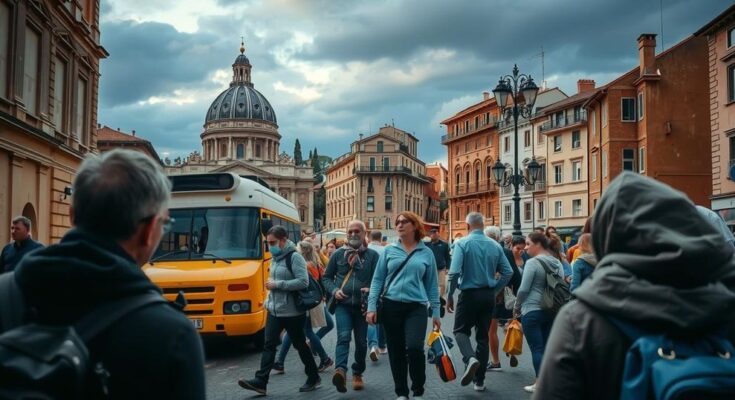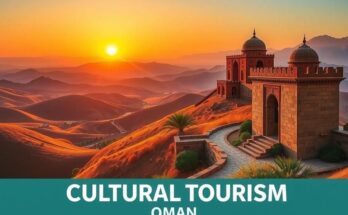Rome is experiencing unprecedented tourist numbers, which have led to frustrations among locals. The impact of overtourism manifests in rising rents, overcrowded spaces, and a changing city dynamic, sparking debates on whether tourism is a burden. As the upcoming Jubilee prepares for an influx of visitors, concerns grow over the balance between catering to tourists and preserving community life.
In the heart of Rome, the clash between a thriving tourism industry and the day-to-day lives of its residents has reached a crescendo. As record numbers of visitors descend upon the city—35 million last year alone, with expectations of 32 million for the upcoming Jubilee—locals find themselves grappling with the challenges of overtourism. What was once a romantic, cinematic landscape of empty piazzas is now a pressure cooker of congestion, soaring rents, and an ever-diminishing sense of community. For many who call Rome home, the picturesque landmarks like the Trevi Fountain have transformed from destinations of beauty into overcrowded attractions rife with disappointment. Anthony Majanlahti, a local historian, voices the frustration felt by many: “Overtourism is a plague… It’s just a shameless cash grab.” The local life, rich with traditions and small rituals, is overshadowed by the throngs of tourists who seem disconnected from the city’s essence. As travelers swarm the streets, households struggle with skyrocketing rents driven by short-term rental platforms like Airbnb. Residents like Simone Alliva, who was forced from his home of 13 years to accommodate a holiday rental, exemplify the growing unease: “The city has turned into a giant Airbnb.” The fabric of Roman life is unraveling; cherished cafés now reserve their outdoor tables for visitors, and the daily rituals that once defined la dolce vita are fading into memory. While the city’s historical allure has long beckoned visitors, recent trends in social media and global tourism dynamics have shifted the landscape dramatically. Despite the beauty and history that Rome offers, locals question whether the influx of tourists enhances or diminishes their experience. “We don’t have enough tour guides, we don’t have enough bus drivers,” says travel guide Mitra Talarman, highlighting the strain on local infrastructure. With the Jubilee fast approaching, city officials are undertaking extensive renovations and beautification projects in anticipation of pilgrims and tourists. This transformation aims to highlight Rome’s glorious past, yet citizens lament lost spaces amidst scaffolding and congestion. They express skepticism over whether future growth will serve the genuine needs of both the city and its inhabitants. As tensions rise, the discourse around overtourism becomes critical. While other popular destinations have enacted measures to address visitor saturation, Italy’s current tourism policy seems complacent, focusing only on expanding tourist flows while neglecting pressing housing issues. The question looms larger as the Jubilee date approaches: “When the Jubilee is finished, what will be left of Rome?” It’s a poignant reminder of the balance between maintaining a vibrant city and preserving its soul amid the relentless tide of tourism. Ultimately, Rome finds itself at a crossroads. It teeters between the grandeur of its past and the unsettling realities of its present, leaving residents to wonder how the future will regard their beloved city amidst the whims of tourists and the pressures of their own living conditions. If changes are not made to address both the influx of visitors and the issues facing locals, Rome may risk losing more than just its charm; it could lose its very identity.
Rome has long been a favored destination, ingrained in the fabric of both its history and culture. This ancient city has been a stage for millions of travelers over the centuries, from aristocrats on the Grand Tour to modern-day influencers posting scenic snapshots on social media. However, the resurgence of tourism following the COVID-19 pandemic has brought significant changes to the dynamics of local life. Record-high tourist numbers have led to increased tension between the city’s residents and the influx of visitors, prompting discussions of whether tourism is still a blessing or has turned into an overwhelming burden on everyday life.
The situation in Rome serves as a microcosm of a global challenge, where beloved destinations must navigate the fine line between welcoming visitors and safeguarding local life. As the Jubilee ushers in another wave of tourists, the pressure mounts for Rome’s authorities to find sustainable solutions that prioritize the well-being of its residents while still cherishing the city’s historical allure. Collective voices from locals may be the key to ensuring that Rome’s storied streets continue to resonate with the echoes of both the past and the living present, rather than becoming mere backdrops for fleeting snapshots.
Original Source: www.euronews.com



